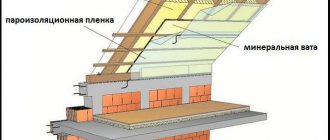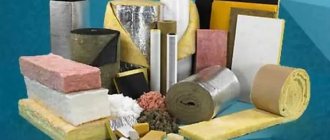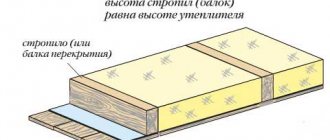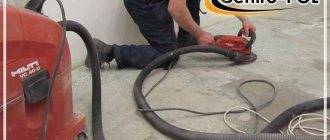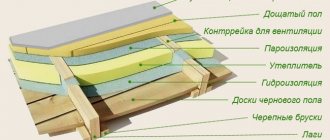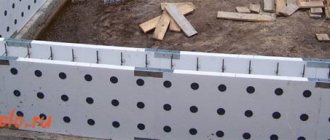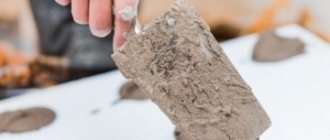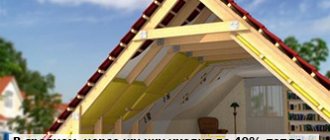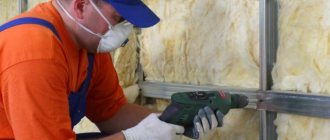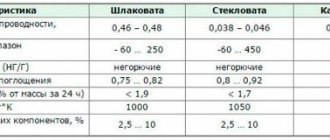February 23, 2021 Ceilings and roofing materials
The roof is not always insulated, but if it is done, it must be done correctly. Many articles have been written on this topic, copies have been made on forums, and videos have been made. But do they all give the right advice? Not at all.
Let's look at the main points of controversy.
How to insulate the under-roof space?
Due to the design features of the roof - the rafters are located at an angle - it is impossible to use bulk and too loose materials for insulation. Therefore, the most popular options are: polystyrene foam (polystyrene), mineral wool in mats, penoplex (extruded polystyrene foam).
- Polystyrene foam is the most attractive in price, so the question of its use is always of interest. It has high heat-insulating properties, it is easy to transport, install and can be processed with any tool (it practically crumbles in your hands). Not all types of polystyrene foam are harmless: when burned and even when heated, it releases very toxic substances, which is why it is not recommended to be used in residential buildings. The situation is complicated by the fact that in addition to official manufacturers, there are also smaller companies where the requirements for production technology and product quality control are not always met.
- Mineral wool is now the most popular material. For insulation, use cotton wool with a density of 35 kg/m3. Despite this, it must be securely fixed between the rafters to prevent subsidence and the formation of voids. In addition, it is necessary to take measures against the insulation getting wet. On both sides, mineral wool is covered with films with varying degrees of vapor permeability. All these installation difficulties, plus the unpredictable properties of films purchased “cheaper”, lead to the opposite result. Instead of a warm roof, you get a weeping ceiling.
- Penoplex is the most expensive of the insulation materials in terms of cost, but it gets its money’s worth. This “relative” of polystyrene foam, which underwent additional processing, became known as extruded polystyrene foam. After extrusion (whoever wants can study this process in detail), penoplex acquires unique properties that have significantly expanded the scope of its application in construction.
Is polystyrene foam safe as insulation?
Officially, this material is classified as environmentally friendly, i.e. those that do not pollute the environment and are not dangerous to humans. But let’s initially determine what influence on the human body can be considered dangerous, and what can be considered prejudice and unnecessary anxiety. You will be very surprised!
Such different concepts
Thus, in the world it is customary to refer to two main concepts for assessing the harm to the human body of certain substances: threshold and linear.
The threshold concept states that all harmful substances in a residential building must be reduced to a certain level for each of them, a threshold, which is fixed by the MPC value (maximum permissible concentration). Those. This is the amount of a harmful substance in the air that can already harm a person. Exceeding this threshold always leads to negative consequences such as illness or even death. Let's give an example: the cheapest foam plastic was chosen as insulation, it was installed incorrectly, there is no normal ventilation in the home. Result: sick liver in the household. But in a well-ventilated house, no one feels harm for a long time. Those. we are talking about the fact that the concentration of a harmful substance below the established threshold does not have a dangerous effect on a person, and a healthy body can easily cope with small toxins. It's like inhaling cigarette smoke from your interlocutor once.
In all countries of the former USSR and modern Russia, building codes are based on the threshold concept. But in Japan, Canada, Germany, the USA and Belgium, the linear concept is at the forefront, the essence of which is that the harmful effect on the human body linearly depends on the total absorption of a certain substance. Those. At one time, cigarette smoke really will not have a significant negative effect on the body, but constant smoking will. The same applies to polystyrene foam: if such insulation is used both on the roof and on the walls, then every day a person absorbs the permissible amount of styrene through the lungs, which is not so little in a year. In a word, small concentrations of poison with long-term use are also harmful. This is easy to show using the example of modern megacities: all transport exhausts and factory emissions do not individually exceed the sanitary threshold, but still life is not sweet for the city residents.
If, when insulating, we adhere not to the first concept, but to the second, then the value of the maximum permissibility of styrene in a residential area will have to be reduced by 594 times!
Of course, polystyrene is used both in the food industry of our country and in medicine. But remember that its toxicity is calculated according to the same concept - threshold. Just note that polystyrene foam and polystyrene are already being phased out in many countries, and in some even banned.
A substance that is not excreted from the body
Now let us recall that styrene is a condensed aromatic compound that contains benzene in its molecule and is bad because it is not excreted from the human body. And, according to modern scientists, in residential construction the threshold for the presence of styrene in the air should be reduced to such minimum values that any polymerization products (including polystyrene foam) should be prohibited.
Properties of penoplex at the service of the developer
There is a lot of good things to say about penoplex.
- The main property is almost zero water absorption. The characteristics give a figure of 0.4-0.5% of the volume for a month. This property is of great importance for insulating foundations and roofs.
- Thermal conductivity is lower than mineral wool. At the same time, it is necessary to take into account the fact that it always remains unchanged, while mineral wool loses its heat-insulating properties when wet.
- The service life of penoplex is 50 years or more. This was found out after frost resistance tests. After repeated cycles of freezing and thawing, the properties of penoplex remained unchanged. Therefore, it is successfully used in structures outside the home.
- The homogeneous structure of extruded polystyrene foam, consisting of evenly spaced cells a fraction of a millimeter in size, gives the material special compressive strength. This allows it to be used both as insulation and as a building material.
- The slabs are produced with an L-shaped edge on all sides for ease and tightness of installation. If necessary, cut with a regular knife.
- It cannot be said that penoplex has zero chemical activity, but most of the “chemistry” for construction work does not react with this material. You should be wary of gasoline, kerosene, acetone, formaldehyde, and epoxy hardeners. You should also not use oil paints.
- As much as penoplex is resistant to frost, it does not like heat. It loses its shape and even melts when the temperature rises, but does not support combustion. Experiments show that when the burner is removed (open fire), the flame goes out. There are also videos - “evidence” of penoplex burning. Most likely, this sample was made with technological violations.
- The biological resistance of slabs made from this insulation is high: they are not susceptible to rotting.
- The main issue of debate regarding any material is environmental friendliness. From this point of view, penoplex is all right. Made using technology, it is safe for humans.
Penoplex is a universal insulation material. By changing some properties of the material, manufacturers obtain penoplex to insulate all parts of the house, from the foundation to the roof.
Video: Penoplex, polystyrene foam, penoizol. Flammability experiment.
Why is foam plastic better than other thermal insulation?
Now let's look at the popular myths about polystyrene foam.
So, the first and most important quality for which this insulation is valued is its high thermal insulation. This coefficient is 0.035-0.048 W/mK at 25C, and 0.20 W/mK for its individual types, according to manufacturers. But absolutely all foamed plastics are afraid of water and quickly absorb it. And expanded polystyrene, which is made using the non-press method, has a water absorption of up to 350% of its mass. And even this is not the limit! And the more moisture in the insulation, the lower its thermal insulation properties.
But in practice, ordinary polystyrene foam lasts only 10-15 years as roof insulation, after which its heat-protective qualities sharply decrease. But extruded polystyrene foam, abbreviated as EPS, is more durable.
But polystyrene foam has the lowest thermal conductivity among all existing roof insulation materials. Even in severe frost, the temperature of 50 mm thick foam and EPS sheets will be +5°C. Plus the following advantages over other heat insulators:
- Soundproof.
- Stable dimensions throughout the entire period.
- Easy to install and cut to required sizes.
- No need for wind protection.
- Resistance to various types of chemicals.
And quite interestingly, in factory conditions they test the strength of extruded polystyrene foam: they lower it into water, heat it to +40°C and cool it to -40°C. Each such cycle is equivalent to one year of operation. Therefore, manufacturers confidently declare that extruded polystyrene foam can serve as under-roof insulation for 50 to 80 years.
And the most important advantage of extruded polystyrene foam is that it does not reduce its thermal insulation properties even when in contact with water. Whereas conventional insulation works properly for only a few years, and then, if mistakes were made in roof insulation, they gradually reduce their thermal insulation qualities and the house has to be heated more and more. This is not to mention other related problems.
But in a roofing pie, polystyrene foam can be damaged by rodents: they will not live in it, but they will make passages. Unless you hide these sheets outside:
Penoplex A - insulation for the foundation
This type of material is characterized by increased strength and, in addition to cladding plinths, foundations and laying floors, is used as a base for garden paths.
The slabs are mounted with special glue and additionally secured with dowel mushrooms. First you need to carry out the entire range of work to level the surface and waterproof the foundation.
Materials for insulating the roof from the inside
Before choosing a material for insulating the roof from the inside with your own hands, you need to understand whether the attic will be used as an attic in the future or whether its function will remain non-residential:
- To equip an additional room, it is necessary to insulate the roof itself from the reverse side.
- In the case of non-residential premises, the most effective would be insulation from the side of the ceilings, which serve as the ceiling for the rooms of your house.
You also need to choose a material for insulation depending on the installation technology and the structure of the roof itself.
C series insulation – for walls and floors
The insulation contains fire retardants for fire protection. Designed for insulating walls and floors from the outside and inside. This can be done in different ways. The simplest and most correct is to install insulation on the wall from the outside. To protect from rodents and atmospheric influences, the slabs are covered with a layer of plaster and painted.
When building a new house, well brickwork is sometimes used to fill the space between the rows of foam slabs. Thanks to the shape of the edges, the thermal insulation layer is sealed; it is possible to use slabs of thinner thickness than polystyrene foam.
Insulating the roof of a house from the inside with your own hands
Before you start insulating the roof from the inside with your own hands, you need to carry out a number of preparatory work:
- Firstly , it is necessary to assess the integrity of the rafter and beam structure, depending on the chosen location of insulation. If rotten elements are found, they must be replaced with new ones.
- Secondly , the wooden parts of the roof must be treated with an antiseptic.
- Thirdly , water supply, heating and electrical wiring systems are monitored in order to avoid further untidiness.
Basic principles of proper insulation:
- When insulating the roof, ventilation gaps must not be blocked.
- If the insulating material is laid in several layers, the joints must be staggered.
- To prevent a gap from forming between the rafters and the seal, the width of the material must be greater than the distance between the wooden structures.
- Do not neglect the use of waterproofing materials.
- To insulate pitched roofs, 200 mm of insulation is used, and in the case of a ceiling - 100 mm.
- Waterproofing and vapor barrier materials are laid overlapping.
Advantages of penoplex K compared to other insulation materials
- The material does not absorb water, so there is no need to install vapor barrier and windproof films.
- Installation is simplified thanks to the L-shaped edges. The slabs are joined without gaps: already in the single-layer version there are no cold bridges. An additional row is laid with the joints shifted relative to the first layer.
- The slabs form an integral rigid surface - this increases the stability of the roof.
- Insulation can be used not only when building a new roof. Repairing and insulating an old roof is easier without installing insulating films.
Video: Roof insulation with polystyrene foam - Build cannot be rebuilt
Roof insulation with foam plastic
There is some difference in the complexity of the process: if insulation occurs after the construction of the roof, then a particularly careful adjustment of the foam plates to the pitch of the rafters and very careful sealing will be required, otherwise cold bridges will form in the cracks, which will cause condensation - and because of it there will be rafters rot and metal parts rust.
Roofing pie composition
The insulating structure has the following components:
- waterproofing layer (water barrier);
- insulation;
- vapor barrier layer;
- interior decoration or roofing.
The insulation is laid in the space between the rafters and carefully adjusted and sealed to avoid cold bridges
There are some mandatory rules:
- It is advisable to lay the foam boards in two layers with a shift, so that the second layer covers the seams of the first.
- It is advisable that the thickness of the rafters be calculated in advance. It should correspond to the thickness of the foam.
- If you have a wooden house, then you can insulate the roof six months after its complete shrinkage, in order to eliminate all defects and deformations before insulation.
- It is necessary to carefully inspect the ceilings and replace rotten parts, then treat everything well with an antiseptic and a pyroprotective compound. Then it will be too late.
- The method of insulation depends on the purpose of the attic space: for a cold attic, only thermal insulation of the floors of living rooms is needed. If it is an attic, then the roof also needs to be insulated.
- It is necessary to clean and dry the areas where thermal insulation will be installed.
- It is necessary to consider ventilation gaps between the rafters and the insulation so that the rafters do not rot.
Table: recommended thickness and density of foam for insulating various parts of the house
| Position | Purpose | Brand | Density | Thickness | Note |
| 1 | For insulation of pitched roofs | PSB-15 | 15 kg/m3 | 50–100 mm | Residential attic, attic, ceiling |
| 2 | For insulation of pitched roofs and walls | PSB-25 | 25 kg/m3 | 50–100 mm | Residential attic, attic, ceiling, walls |
| 3 | For insulation of flat roofs and attic floors | PSB-35 | 35 kg/m3 | 50–100 mm | Residential attic, attic, ceiling, flat roof |
Styrofoam fastening
Methods for fixing foam plastic can be as follows:
- laying pieces of foam plastic between the rafters;
Polystyrene foam is most often inserted between the rafters - laying foam plastic as a continuous “carpet” with foaming the cracks between them;
When laying polystyrene foam in a continuous layer, it is necessary to foam the gaps between the sheets - gluing (facade frost-resistant glue or liquid nails);
- use of special fasteners (anchor bolts, umbrella nails or self-tapping screws).
If large areas are covered with a continuous layer of polystyrene foam, then the sheets can be secured with special dowel nails
Insulation of pitched roofs
Required tools and additional materials:
- Styrofoam;
- film for waterproofing;
- vapor barrier membrane;
- stapler for fixing film;
- knife;
- scissors;
- slats for fixing foam plastic (if necessary);
- polyurethane foam;
- screwdriver;
- hammer;
- drill;
- nails;
- self-tapping screws
Insulation from the inside
- We fasten the waterproofing with a stapler to the sheathing in the spaces between the rafters.
The waterproofing film is attached to the sheathing in the spaces between the rafters - We install the sheathing on the roof so that there is an air gap between it and the foam for ventilation. Another option: we drive nails into the rafters and stretch a mesh of string over them, and put foam plastic on it.
- We cut the foam into sheets of such a size that they are slightly wider than the distance between the rafters.
- We insert foam plastic between the rafters with force. We foam the joints.
Sheets of foam plastic are specially cut slightly wider than the distance between the rafters so that they fit into the opening with force - We fasten it with lathing slats (then they are parallel to the floor in increments of about half a meter), a mesh of twine or umbrella nails.
- Then we strengthen the vapor barrier on the rafters with a stapler (without stretching it, it’s even better if it sags slightly).
- Then we cover everything with finishing materials: plasterboard, clapboard - also with some gap from the foam.
Video: roof insulation with foam plastic from the inside
Insulation from outside
- We fasten the vapor barrier to the rafters with a stapler.
The vapor barrier is stapled directly to the rafters - We install the sheathing with an air gap for ventilation in the same way as in the previous case.
- We cut the foam into sheets of such a size that they are slightly wider than the distance between the rafters.
- We insert foam plastic between the rafters with force. We foam the joints.
- We fasten it with lathing slats (then they are packed in increments of about half a meter), a mesh of twine or umbrella nails.
- We place waterproofing (regular roofing felt, foil or polyethylene) on top of the foam without stretching it.
- We stuff the sheathing.
- We lay and fix the roofing covering.
Scheme of external roof insulation with foam plastic
Insulation of a flat roof
Flat roofs are usually subject to heavy loads. Therefore, in this case it is advisable to use penoplex, but you can get by with polystyrene foam.
For a flat roof, two methods of insulation are also possible.
Insulation from outside, or “rolled ceiling”
- We prepare the roof surface, clean and level it.
- We lay a vapor barrier membrane.
- We place the foam plastic on glue or mastic.
Foam plastic is laid with a vapor barrier membrane. If it is necessary to lay several layers of insulation, then each subsequent layer is laid with a shift relative to the previous one - We foam the seams.
- We lay waterproofing (roofing felt or geotextile) and seal the seams.
- We fill everything with gravel to a thickness of 5 cm, or lay it with paving slabs.
This kind of roofing is called ballast. - Next, you can lay geotextiles, a cement screed on top of it, and then fuse a bitumen roof onto it. Recently, “hanging gardens” have come into fashion - a reinforced coating is laid on top of the insulation layer by layer, then a special membrane, geotextiles and fertile soil. And already there you can plant plants with short roots.
Insulation from the inside, or “false ceiling”
- We carry out the work in exactly the same way as when insulating a pitched roof from the inside.
- We install a finishing ceiling on top of the vapor barrier and sheathing - made of boards, lining, chipboard or plasterboard.
In the case of roof insulation with polystyrene foam, its property of absolute non-wetting cannot be overestimated!
Here there is no need for a vapor-transparent film duplicating the roof covering. Water, having leaked from the roof, will successfully flow down the insulation without changing its thermal insulation properties. It is impossible to wet polystyrene from above if the roof leaks, but it is necessary to protect it from below from water vapor from the house formed during the life of household members, just like cotton wool. Polystyrene is vapor permeable. Voddina
https://www.mastergrad.com/forums/t42311-a-chem-penoplast-ploh-dlya-utepleniya-mansardy/
Installation of penoplex in different ways
Another advantage of penoplex can be considered “maneuverability” during installation: it can be laid on top of the rafters, insulation can be installed underneath them, slabs can be laid as an additional layer of insulation during reconstruction, and insulation can be applied to the attic floor.
Penoplex over rafters
Penoplex roof insulation scheme
The slabs are laid when the rafter system is completely assembled, the sheathing is secured and nailed.
- At the bottom of the rafters, at the border of the insulated zone, a block as thick as insulation boards is nailed. This is the starting rail. It is placed at an equal distance from the edge, along all rafter legs. Starting from there, lay the foam boards in a checkerboard pattern. The thickness of the layer is determined by the geographical location of the construction site. It is always better to lay two or three layers than one, and securely seal the joints. For greater confidence, the insulation boards are secured with screws with mushroom caps and the seams are taped.
- The bars are stuffed on top of the insulation, oriented from top to bottom. This is the so-called ventilated gap. It is needed for free air circulation from the spotlights to the ridge. Let us note one more plus - you can walk on the insulation.
- Then the sheathing is attached to install the roofing. These can be bars fixed at a certain pitch or a continuous OSB covering for soft or rolled roofing.
- The insulation on the ridge is laid closely, a gap is left only when installing the roofing.
Reconstruction of roof insulation
In this case, a layer of penoplex is attached to the rafters from inside the attic. The layer of existing insulation is covered with an additional vapor barrier film. The slabs are also installed with joint bandaging and gluing. The interior trim is attached to the ventilation gap bars.
Video: Roof insulation with extruded polystyrene foam
Insulation of the attic floor
A leveling screed is laid on the concrete slab, covered with a vapor barrier and a calculated layer of insulation is laid. Then a sand-cement screed is poured onto the separating film.
In houses with wooden floors, a vapor barrier is laid on the ceiling lined underneath, the space between the beams is filled with penoplex and covered with sheets of OSB or plywood.
It is always recommended to look at the websites of material manufacturers for detailed instructions.
Add a comment Cancel reply
You must be logged in to post a comment.
How to insulate a roof with penoplex
The procedure for insulating a roof with penoplex allows you to create a heat-insulating layer under a pitched roof or on a flat roof. Using durable modern material, you can create a dense protective layer that will protect the roof from the negative influence of the external environment and prevent heat from leaking out of the room. In addition to the synthetic layer, penoplex also includes other materials that enhance the effect of the protective layer. In this article we will talk about which components to choose and how to use them to create a protective layer.
The nuances of roof insulation with penoplex
To begin with, we note that the Penoplex material is a domestic analogue of expanded polystyrene, which is often used in the West for roof insulation. This material is produced using an extruder. This is a specialized device that is designed to pass a liquid mass under strong pressure. Russian penoplex is produced according to the same principle, and the manufacturer is the company of the same name. The material turns out to be no worse than its foreign counterpart, but at the same time its price is much lower, which allows a large audience of buyers to purchase penoplex for roof insulation. The material is based on so-called closed cells, due to which the panels are dense and can withstand heavy loads. Thus, the foam layer with which you insulate the roof can also be used as an additional platform when working with a flat roof. This material can be purchased in the form of separate panels of different thicknesses, depending on your needs and type of roof. The minimum slab thickness is 3 cm, the maximum is 10. If a specific case requires this, the slabs can be laid in several rows.
When installing slabs, you can use various working methods:
•Classical, during which the slabs are placed under a waterproofing layer. In this case, you need to be extremely careful when walking on the floor so as not to damage one of the layers. Therefore, installing penoplex in the classic way requires special care and accuracy. •The inversion method involves placing the slabs under a moisture-proof layer. In this case, the materials form a dense layer, as a result of which the free area can be further exploited. Thus, if you want to place a summer garden, tables or even an entire terrace on the roof, then you need to choose this particular method of installing a protective layer.
Penoplex material can also be used to repair roofs. In this case, waterproofing material is laid on the old roof layer and only after that the penoplex is placed. In addition, an additional waterproofing layer and expanded clay are placed on top of this layer. Sheet material is best suited for insulating an attic roof. In this case, insulation sheets can be placed inside the frame or as a top layer. This already depends on the approach of the master who performs the roof insulation. In this case, even thin panels can be used. This will help save on roof insulation.
What are the advantages of roof insulation with penoplex:
•Slabs do not absorb water. During experiments, when the plates were completely immersed in water, their mass increased by only 0.4%. Moreover, after water gets on the slabs, they do not deform. • Their penoplex slabs are very light and therefore easy to use. When insulating the roof, they will not create a heavy layer that would heavily load the main structure. Therefore, even if you need to insulate a building whose roof is not a very large structure, you can use the presented material without fear that the structure will be overloaded.
•Individual panels are in good contact with each other, since milling is provided for this on the sides of the layers
• Thanks to the use of the presented panels, you can quickly and inexpensively repair any type of roof • The plates are not affected by low or high temperatures, as well as precipitation, so you don’t have to worry about them changing shape under any influence.
•Foam boards are easy to process, which further reduces the time required to work with the material being presented.
•The roof, which has been insulated with this material, can be used as an additional platform, for example, for a terrace. The long service life of the material allows you to not worry about the need for repeated work for a long time.
Despite all the indicated advantages of this convenient and modern material, there are still some disadvantages that do not significantly change the fact that penoplex is an effective choice among materials in this area. Among the disadvantages of penoplex we can highlight:
•Under the influence of very high temperatures, the material can release harmful substances into the air, so many craftsmen use penoplex only on the outside of the roof.
•If you need to insulate the attic, this process may take longer than usual, since you will have to cut out the elements at their location
•When installing penoplex, you must not forget about the need to cover it with an additional protective layer. It is used to prevent direct sunlight from reducing the strength of this material.
How does the roof insulation process work?
How the roof insulation process will proceed depends on what type of roof is present on your building. If the roof is flat, you need to use plates with increased density. This is necessary so that the finished structure can withstand heavy loads. In this case, the panels are placed on the outside of the roof.
When insulating attic structures, penoplex is attached from the inside. In this case, there is no need to use high-density boards. And, as already mentioned, in no case should we forget about the need to use a protective layer that will protect the roof and penoplex from the negative influence of the external environment when exposed to sunlight or heavy precipitation.
How to choose high-quality insulation material?
To ensure that your roof is properly protected, it is important to use high-quality material while working. In this case, you need to know how to choose products of proper quality and protect yourself from defective goods.
So, when choosing penoplex, you should pay attention to the following nuances:
•On the structure of individual plates. If you see granules on them that are clearly visible, this means that such material will not be durable. Since high-quality samples are a single structure with invisible granules
•Defective slabs crack when touched. If you buy such a product, then during installation the blocks will be destroyed and such insulation will be of no use. Do not forget to check the integrity of the factory film in which high-quality slabs are packaged. The film must not be damaged.
•A high-quality factory product always has a sticker on the packaging, which contains information about the composition of the insulation and its operating conditions. •The ideal models for insulation are Penoplex types 31 and 31C. Their cost is affordable for everyone, and in terms of load-bearing characteristics they do not lag behind. But if you need to insulate a flat roof, then you already know that you need stronger models. In this case, Penoplex models 35 and 45 would be ideal. They are designed to work with heavy loads and will also be useful to you if you want to build additional structures on the roof.
To attach the slabs to the concrete bases, adhesive materials are used. In this case, you can give preference to dry type polyurethane glue. Tile adhesive is also a suitable option; moreover, it will cost less than weeks of specialized products. Another important point is the application of an additional waterproofing layer. It is he who will protect this layer and those lying underneath from moisture due to rain and other precipitation.
On our website you will find Penoplex Roofing at the lowest price. Buy foam roofing from the best direct dealer
Disadvantages of flat roofs
With all the advantages and disadvantages of a flat roof, it has a number of disadvantages. For example, water often accumulates on it, which over time can lead to water leaking into the house. Snow also accumulates on the roof, increasing its weight. However, the most important disadvantage is that a fairly large amount of heat is lost through such a roof. The materials used for roofing (concrete, steel, etc.) have high thermal conductivity, and in the room warm air accumulates mainly under the ceiling. In addition, houses with such roofing do not have attics. As a result, the annual loss of heat, and therefore money, turns out to be very significant.
